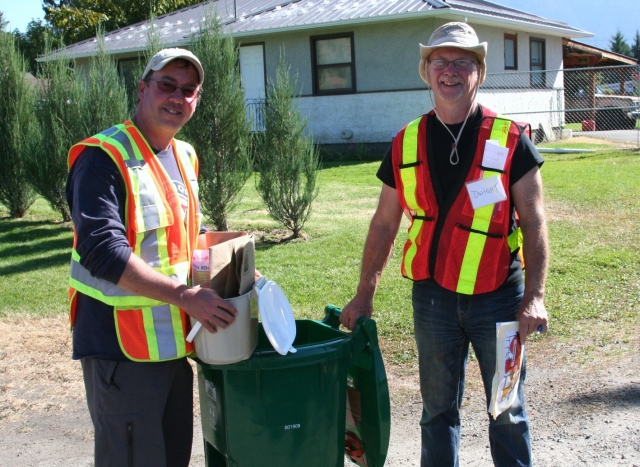Compost collection starts city-wide next week
Bright green garbage cans have been popping up on doorsteps all over Grand Forks this past week as a sign of a new approach in local garbage collection — the Foodscraps Collection program. While some residents give praise for the efforts to curb garbage volumes, others are not impressed.
For the past eight months residents of the Valmar subdivision have been participating in a pilot version of the program, which was deemed successful enough to start city-wide Oct. 2.
As of next week, all Grand Forks households will be reduced to one bag of garbage collected every two weeks rather than one bag a week. Instead, there will be a weekly foodscraps collection.
Tim Dueck, solid waste program coordinator with the Regional District of Kootenay Boundary, said three months into the program, the Valmar subdivision participants had reduced their garbage output by nearly half when using the green bins for compost.
“They recognized their efforts were producing a result,” said Dueck.
Morgan Van Kirk, a Valmar resident who has been participating in the Foodscraps Collection program pilot project since it began in late January 2012, said he liked the idea, but it could use some improvements.
Van Kirk used to live in Victoria, where they also have a composting program. There residents would receive a free bag of compost every year as an incentive to participate in the program, he said.
“I think if we had incentives then it would be really cool to get back the soil. Then you’d have a little reward for doing something,” he said.
Dueck said at this time the compost being created from the program has not be slated for distribution.
“The incentive inherent in our program is that if you create garbage, you pay for it,” said Dueck. And that extra garbage bag — because only one bag of garbage per household every other week will be picked up — will cost $3.
While there is normally only two people in Van Kirk’s household, over the summer he had guests and got to experience how the system worked with two extra adults and then with a family who had a baby in diapers.
He found the compost bin size and being picked up once a week was fine for two adults and even four adults (although it was nearly overflowing). But when it came to having children around, the bins and the every other week garbage pick up just didn’t cut it.
“Having the garbage go out every two weeks is such a pain,” he said. “I wish they’d pick it up all together … The diapers couldn’t be put into the green bins so they had to sit in the garbage for two weeks, which was not good.”
What Van Kirk didn’t know was that those stinky diapers could have also gone into the green bins.
The green bins aren’t like your back yard composter because you can include meat, bones, diapers, tissue paper, paper towel, cat litter and dog poo in them too.
“The intention is good, so I think it is good, but the extra expense (of the bin liners) is annoying,” said Van Kirk.
“I’m quite impressed,” said Dueck of the response so far. “The biggest negative comment is ‘what took you so long?'”
“When studies show that 40 per cent of our garbage is compostables, it doesn’t make sense for us to ignore that.”
Even after years of recycling, Grand Forks residents are still putting recyclables into the trash.
“There are 50 per cent recyclables in our garbage still,” said Dueck. “As a voluntary program (recycling) has led to a plateau. With a $3 a bag charge, we hope people will take a second look at our recycling too.”
There has been some dissension in the ranks. Last week the Facebook page “GF Citizens Against the Green Bins” was started up.
The page included links from residents of other municipalities who have green bins. Some of the concerns with the bins ranged from not being family friendly due to the reduction in garbage collection to maggot growth within the bins.
The program is costing about $325,000 a year to run. That money is paid for through the city taxes at about $10 a month or $120 a year per household.
For those who already do backyard composting — Dueck says keep up the good work. This program is not about attracting more compostable materials but by reducing what is going into the landfill, he said.
If all goes as planned, Area C and Area D will soon be joining the program, said Dueck.
The compostables collected in the program will go to the Grand Forks landfill where they will be composted en masse and used to amend soil in local parks and at old landfills that are being reclaimed. This program is a part of a much larger one the RDKB is involved with — the reduction of the local carbon footprint.
For more information about the Foodscraps Collection program or the collection schedule check out the regional district website at www.rdkb.com .






















